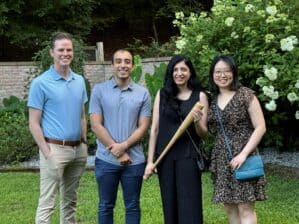Program Goals
The primary goal for the UAMS Radiation Oncology Residency Program is to prepare residents for a career in radiation oncology practice in either a community or academic setting. Our community setting will focus on practice in rural Arkansas, while the academic setting will develop either clinical educators, with the opportunity to teach medical students and residents, or physician scientists, focusing on translational and clinical cancer research. Our strong multidisciplinary program will provide exposure to a variety of clinical instructors who will reinforce the importance of multidisciplinary treatment planning in clinical oncology practice.
Expectations of Residents
First-Year Residents

During the first year of residency, residents will rotate through four services, including a combination of Breast, Gynecology, Pediatrics, Hematology, Lung, Mediastinum, Gastrointestinal, Genitourinary, Head & Neck, and Skin/Soft Tissue, Bone, and Central Nervous System. Through these rotations, the resident will be exposed to general medical and surgical principles, in addition to medical oncology and radiation oncology. The resident will learn the essentials of patient evaluation, diagnosis, and staging in oncology. The general principles of radiation oncology, objectives of treatment, potential complications, and general treatment guidelines will be learned through exposure to cases and discussions with the attending staff regarding appropriate management, case presentations, morbidity and mortality conference, tumor board and didactic sessions.
The resident will be exposed to simulations, treatment planning and the fundamental principles of radiation delivery through case management and ongoing didactic sessions. During the first year, however, it is understood that the resident will not have a detailed understanding of all aspects of clinical radiation oncology and patient management. Throughout the first year and subsequent years, the basic principles of radiation biology and radiation physics will be taught to build a solid foundation and understanding of the discipline.
Second-Year Residents
Through continued case exposure, the resident will refine his/her skills and increase his/her fund of knowledge with respect to the diagnosis, staging and management of oncology patients. During this year, the resident will become more involved in the intricacies of the technical aspects of radiation and will be expected, by the end of this year, to evaluate, stage, and formulate a therapeutic plan for most patients. The resident will, by this stage, understand all of the basic principles of radiation biology and physics, upon which the delivery of radiation is based. The resident will have a basic understanding of treatment planning and dosimetry and will understand and be able to communicate a therapeutic plan for a patient undergoing radiation.
The resident may also be given three months of electives during the second year, based on the discretion of the program director. During this block in the second year, the resident may be allowed to pursue a research elective, radiology, physics, pathology, medical oncology or other electives at UAMS. All residents are strongly encouraged to take the physics elective in their PGY2/PGY3 years, in order to assure comprehension of basic physics and to teach the fundamentals of patient positioning, simulation, and treatment planning and delivery.
Third-Year Residents
The resident, through additional case exposures, will further refine his/her skill and improve his/her fund of knowledge in all oncology subspecialties. Additional exposure to brachytherapy, IMRT, and stereotactic radiosurgery will provide the resident with knowledge regarding the use of these tools in patient management. By the end of this year, the resident will have been exposed to all types of cases and be able to formulate and carry out a therapeutic plan for the majority of cases. The resident will have a thorough understanding of the classic and current literature, and be capable of effectively communicating the rationale for therapeutic strategies as supported by the available literature. Through exposure to patients in the follow-up clinics, the resident will understand the potential complications of radiation, and be able to effectively communicate the risks of radiation to a patient, physicians, nurses, and other team members. The resident by this time will have a more sophisticated understanding of therapeutic options, and be able to communicate and support multiple management options, their potential risks and benefits, and understand evolving experimental strategies and future directions.
Fourth-Year Residents
By the fourth year, the resident will, for the majority of oncology patients, be capable of completely carrying out the workup, diagnosis, staging, and management as it relates to radiation oncology. The resident will be able to use literature to justify a proposed treatment regimen and be able to communicate his/her management plan to the patient (including its potential benefits, risks, outcomes and treatment plan). The resident will be able to communicate the intended plan to the radiation therapy technician, dosimetrist, physics staff, medical oncology staff, surgical oncology staff and other members involved in the care of the patient. Along with this, the resident will demonstrate a level of understanding of treatment planning and physics sufficient to consider alternative strategies.
By the end of the fourth year, the resident will have completed his/her research elective and will understand evolving treatment strategies and future directions for research and development as it relates to our specialty.
More Information
-
How to Apply
Learn how to apply to this residency program.
-
Residents
Meet our Radiation Oncology Medical Residents.
-
Radiation Oncology Interest Group
Dedicated to fostering an interest in the exciting field of Radiation Oncology.
